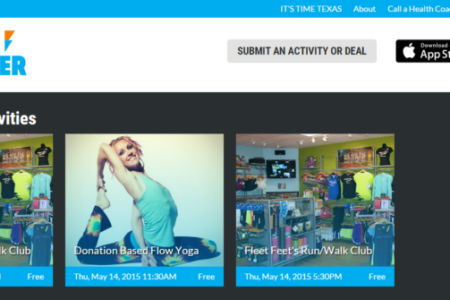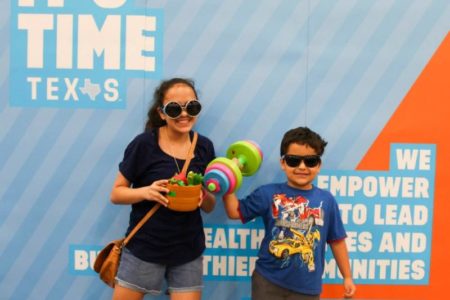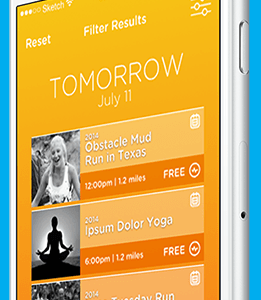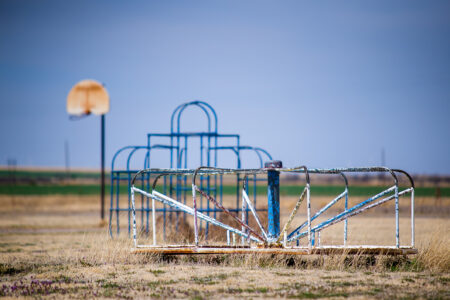Share On Social!
Improved technology, like smart phones and tablets, is often blamed for increasing unhealthy, sedentary lifestyles in children, especially Latino children. But what if this technology could be used to actually promote healthy living? Learn how a non-profit in Austin, Texas created a free mobile App that connects folks ready to get healthier with countless opportunities right in their backyard.
EMERGENCE
Awareness: Chances are most Texans know someone, even kids, with diet-related health conditions. In fact, 42.8% of 4th graders in Texas are overweight or obese.
Making healthier lifestyle changes can make a big difference, especially for Latino kids, who make up a significant percentage of kids in Texas and are more likely to be overweight.
Fortunately, IT’S TIME TEXAS (ITT) is one of the many organizations across the state working to empower people to lead healthier lives and build healthier communities. The Austin, Texas-based nonprofit engages in all aspects of grassroots change-making, from hosting events and trainings to advocating for healthy living policies to developing programs.
“We’re always trying to find tools and resources that allow others to take action,” said Thomas Young, director of programs for IT’S TIME TEXAS.

Learn: But ITT found that local people who wanted to get healthy couldn’t find when or where to do so.
“There’s nothing out there to help you find healthy opportunities in your community,” Young said.
A nearby organization, the Dell Children’s Medical Center of Central Texas, which also was looking for innovative ways to connect patients to healthy opportunities in their neighborhoods, ran across the same issue.
It’s hard for doctors to recommend more physical activity without being able tell families exactly what to do or where to do it, said Dr. Steven Pont, medical director for the Texas Center for the Prevention and Treatment of Childhood Obesity at Dell Children’s.
“A huge barrier that health care providers face is we don’t always know about all the opportunities going on in the places where we live,” Pont said.
In 2014, ITT and Dell Children’s came together to search for innovative remedies to engage folks in healthy living activities that were already happening near them.
“For years, we have witnessed a significant expansion of high quality programs, products, and services that help people lead healthier lives, while, at the same time, we have heard from our friends in the medical community that there is a growing need to connect patients with these kinds of resources in their community,” said ITT CEO Baker Harrell.
Frame Issue: The ITT-Dell Children’s partnership yielded a new vision: utilize technology and community to connect people with activities happening around them.
What if a mobile app could bring local physical activity, nutrition and wellness right to your fingertips?
“If more people know what opportunities are there they will be more likely to fit them into their schedule,” said Dr. Pont.
Thus, the idea for a new app, which they would call Choose Healthier, was born.
“The Choose Healthier program began like most entrepreneurial endeavors—as a desire to solve what we believe is a pressing problem,” said ITT CEO Baker Harrell.
DEVELOPMENT

Education: Since ITT is based in Austin, the Austin area would be the first target for the new App.
A team of around 10 interns, full-time employees and contractors began identifying and mapping out wellness-related activities all over Austin. Young said this team calls potential activity providers or vendors, like a gym or a chiropractor, explains the Choose Healthier App and asks if they would like to have their services mapped.
“It’s not only for the individual trying to find an activity, it’s for the business trying to promote their activities,” he said.
The team uses spreadsheets to keep track of all business information, like the website, main contact and a link to the schedule so that ITT can sync that information with the geo-locating information on the App’s map.
Young said they contact every business or organization they feature and have to get a “verbal yes” from an authority figure. He said the App is as much for businesses as for the folks who will use their services.
“It takes time but it has allowed us to get to know the vender community more closely…and this is allowing them know each other better and to network together in the long run,” he said.
Another way vendors can connect to the App is by creating a provider account at choosehealthier.org. That way, the provider can upload class information and prices themselves. Once it gets verified and approved by an ITT team member, the information will be live for all App users to see.
To create and design the actual technology for the App, ITT contacted Chaotic Moon, a local development shop in Austin.
Mobilization: Young connected with Cherelle VanBrakle, the project coordinator at Dell Children’s obesity center, to help promote the App.
“He and I worked on communications and events that were planned throughout the semester to promote the App,” said VanBrakle.
In fact, Dell Children’s offered a lot of promotional help. They have a huge network, including 10-13 thousand employees. Young said they designed promo cards for the medical center to hand out explaining the Choose Healthier App. The medical center is also helping with earned media, like T.V. and radio spots.
ITT is very active on social media, with over 1,100 followers on Twitter and over 3,000 “likes” on Facebook, so a lot of promotion for the new App was on those channels.
Young said that because ITT has a strong relationship with local school districts, school district employees were made aware of the new App and encouraged to download the App when available.
The medical community, businesses, foundations and government organizations—including the Michael and Susan Dell Center for Healthy Living, the RGK Foundation, the United Way of Greater Austin, H-E-B, Blue Cross and Blue Shield of Texas, and the Texas Health and Human Services Commission—saw the benefits the App would bring.
But would the general public?
Debate: Easy access, regardless of a person’s race, income or where they lived, was essential for the Choose Healthier App, Young said.
So they envisioned a free app.
The app would be accessible on both Apple and Android phone platforms, as well as desktop computers and other internet-access devices.
“We wanted to be sure that everybody had access,” said Young.
Additionally, the geo-locating aspect of the App is crucial to accessibility and was a “must-have.”
Users can filter activities as close as one mile from their location or as far as 20, Young said.
“If you don’t have a bus route, you know there is something a mile from you…even if you had to walk or bike, you could do it,” he said.
ENACTMENT
Activation/Frame Policy: The App, designed to be user friendly, recognizes a user’s current location (or they enter a location, too) and allows users to filter by type of activity, price and location.
They can save favorite activities and share them on social media.
To keep things fresh, users can only see activities listed in the next seven days.
“We want people to be able to come back to this app on a weekly basis and see what’s going on around them that week,” Young said.
The app was beta-tested and Chaotic Moon preemptively fixed what few glitches came up.
Young and VanBrakle were growing more and more confident that the App could be a success.
“It eases our worry about ‘Will this actually be a good App?’” she said.
Change: As of late Spring 2015, the Choose Healthier App has been available to download. People can visit ChooseHealthier.org to see activities online or register their business or organization’s activities for free.
At the time of the launch, the App featured more than 300 venders and 30,000 activities, numbers that “grow exponentially every day,” said Young.
“We developed the Choose Healthier mobile app, website, and coaching hotline to…significantly increase access to healthy resources in one’s community and provide a support network to help people achieve and sustain a healthy lifestyle,” Harrell said.
IMPLEMENTATION

Implementation: Health care providers at Dell Children’s and other clinic will have Choose Healthier App flyers to pass out to patients at the end of their visit.
Supporting the App will be the Choose Healthier Coach Hotline.
Developed in coordination with the United Way for Greater Austin and the University of Texas School of Public Health, the Choose Healthier Coach Hotline is a source of health information and will be able to use the Choose Healthier App to find activities near the caller.
“We have a fulltime coach answering phone calls from 9-6 p.m. CST on a free hotline,” said Young.
An updated version of Choose Healthier will be available in June 2015.
Equity: All the App collaborators agreed that Choose Healthier and its functionalities had to be available to all, especially underserved populations.
Dr. Pont said he would like to see App content be available in Spanish as well as English to meet the needs of central Texans who may be more comfortable reading and speaking in Spanish.
“If we can demonstrate confidence in the App, then we can make the case for finding funding to make it available in Spanish,” he said. He also mentioned that currently service providers could choose to make their information in Spanish as well.
Another way to ensure equity, said Young, is by allowing folks who sign up as Choose Healthier members to have access to Choose Healthier deals. The vision is that members would have access to deals provided by certain venders, like a free month of Zumba.
“We want to bring awareness but also greater access with at least a chance for a discount,” he said.
Sustainability: There are already talks of implementing the Choose Healthier App in other Texas cities.
In fact, Young said businesses from other cities have already shown interest and are reaching out to ITT.
As for day-to-day activities, Young said he and his team will continue mapping new areas, reaching out to new businesses and managing their current relationships.
“We want to make sure they know this program is here for them,” he said.
They plan on highlighting noteworthy businesses and news about the App on the ITT blog.
Dr. Pont can point to a few ways he’ll know the App has been a success, but there is one simple conversation he is looking forward to the most.
“When I’m at the clinic, if a patient tells me, ‘Hey, that app was really helpful,’ that’s going to be great,” said Dr. Pont.
This success story was produced by Salud America! with support from the Robert Wood Johnson Foundation.
The stories are intended for educational and informative purposes. References to specific policymakers, individuals, schools, policies, or companies have been included solely to advance these purposes and do not constitute an endorsement, sponsorship, or recommendation. Stories are based on and told by real community members and are the opinions and views of the individuals whose stories are told. Organization and activities described were not supported by Salud America! or the Robert Wood Johnson Foundation and do not necessarily represent the views of Salud America! or the Robert Wood Johnson Foundation.
ABOUT THE PROGRAM
Salud America! The RWJF Research Network to Prevent Obesity Among Latino Children is a national program of the Robert Wood Johnson Foundation. The program aims to educate researchers, decision-makers, community leaders, and the public in contributing toward healthier Latino communities and seeking environmental and policy solutions to the epidemic of Latino childhood obesity. The network is directed by the Institute for Health Promotion Research at the University of Texas Health Science Center at San Antonio.
For more information, visit http://www.salud-america.org.
By The Numbers
33
percent
of Latinos live within walking distance (<1 mile) of a park
This success story was produced by Salud America! with support from the Robert Wood Johnson Foundation.
The stories are intended for educational and informative purposes. References to specific policymakers, individuals, schools, policies, or companies have been included solely to advance these purposes and do not constitute an endorsement, sponsorship, or recommendation. Stories are based on and told by real community members and are the opinions and views of the individuals whose stories are told. Organization and activities described were not supported by Salud America! or the Robert Wood Johnson Foundation and do not necessarily represent the views of Salud America! or the Robert Wood Johnson Foundation.



